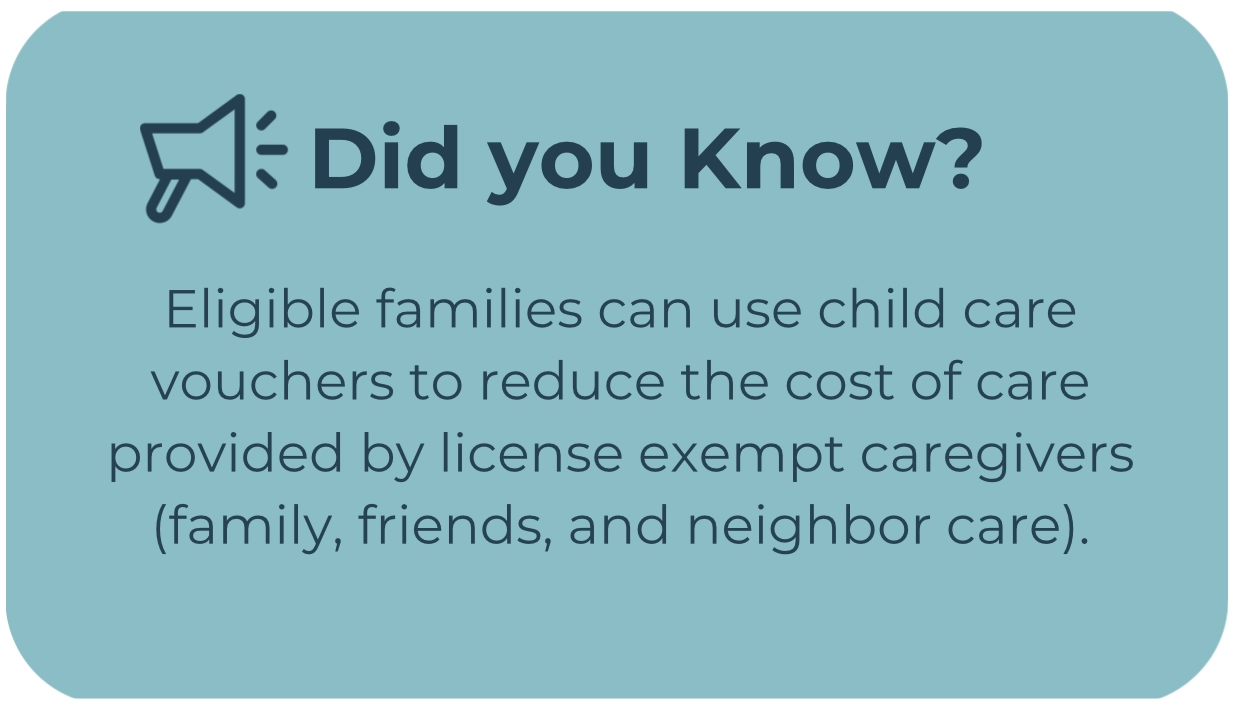Free or Reduced Cost Child Care

Based on income or special status, families may qualify for free or reduced cost child care through voucher programs, direct contracts, or special status opportunities. Read on to learn about some of these opportunities and contact your local Resource & Referral (R&R) Agency to determine eligibility and apply for subsidy assistance. When you are ready, the R&R can also help you locate child care programs near you that accept subsidies.

Voucher Programs
Programs that provide families with vouchers to reduce or cover the cost of child care.
- CalWORKs Child Care
A state-run public assistance program that helps families access immediate child care as the parent works or performs their welfare-to-work activity. This program is administered in three stages. Learn more about the different stages and eligibility requirements on the CDSS website.
- Alternative Payment Program (CAPP)
Agencies contract directly with the California Department of Social Services (CDSS) to distribute federal and state subsidies (vouchers) for CalWORKs and eligible low-income, working families. The program helps to ensure working parents can choose child care programs that best meet their families’ needs. The Resource and Referral (R&R) agencies that serve LA City also function as CAPP agencies. Locate your local R&R here or find a list of CAPP agencies on the Thriving Families CA website.
- Emergency Child Care Bridge Program for Children in Foster Care (Bridge Program)
the Bridge Program provides short-term (typically 6-12 months) child care vouchers to reduce the cost of child care for families bringing a child in the foster care system into their home or for parenting youth in the foster care system. Subsidies can be used for care in centers, in family child care homes, or provided by license-exempt caregivers (FFNs). Learn more about the program and eligibility requirements on the CDSS website.

Direct Contracts
For these programs, state and federal entities contract directly with child care providers to reduce or cover the cost of child care for eligible families. To learn more about each program, visit the CDSS website.
- California State Preschool Program (CSPP)
CSPP Provides both part-day and full-day services for eligible children ages 2-5 years.
- California’s General Child Care and Development (CCTR)
CCTR programs provide child development services for children ages 0-12 years and older children with exceptional needs.
- Head Start
A federal program that provides free child care for families living below the federal poverty line. Other vulnerable populations such as children in foster care, children who are homeless, or children in families that receive public assistance may also qualify. Head Start serves children ages 3-5 while Early Head Start serves infants and toddlers under the age of 3.
To learn more and find a Head Start program near you, visit the Head Start Early Childhood Learning and Knowledge Center website.
- Family Child Care Home Education Networks (FCCHEN)
A group of licensed family child care homes focused on services for low-income families that receive additional state funding for participating in enhanced training, meeting stricter education code standards, and providing additional supportive services for families (such as parenting education and social and health service referrals).
- Migrant Program (CMIG)
Program provides services to families who earn at least 50% of their total gross income from employment in fishing, agriculture, or agriculturally related work.

Special Status Opportunities
Local and federal governments provide resources to help families working in certain industries pay for care. They include:
- Military Child Care
The Los Angeles Air Force Base Child Development Center is a child care center operated by the Department of Defense. The program offers full day care to infants, toddlers, and preschool-age children. To learn more, visit the Military Child Care website.
Military families may also be eligible for the Military Child Care in Your Neighborhood (MCCYN), a fee-assistance program to help reduce the cost of community-based care.
- Employer-Reduced Child Care
Some employers may provide child care support as part of their benefits package for employees. Contact your employer to determine if they provide any of the following opportunities.
- On-site Child Care: Some employers have an on-site child care program at the workplace and may provide employees with discounted tuition as part of their benefits package.
- Cash Subsidies: Some employers subsidize child care costs for their employees by paying directly for care or paying into a dependent care spending account.
- Dependent Care Flexible Spending Accounts (DCFSA): This is a pre-tax benefit account used to pay for eligible dependent care expenses. The money that is deposited into a DCFSA is not subject to payroll taxes. Learn about eligible expenses and how much you can save with the DCFSA calculator tool on the Federal Flexible Spending Account Program website.
Tax Benefits

Families may be eligible for thousands in federal and state tax credits. Eligible taxpayers can use tax credits to reduce their tax bill and potentially increase their refund. Families with children may be eligible for the state and federal tax credits listed below.

State tax credits may be more accessible than federal tax credits because families can be eligible for most state tax credits with an Individual Taxpayer Identification Number (ITIN), whereas many federal tax credits require a Social Security Number (SSN).
State Tax Credits
- California Earned Income Tax Credit
The California Earned Income Tax Credit (CalEITC) provides support for low-income, working Californians. Families may be eligible for thousands of dollars in cash back or a reduction of the taxes they owe. Learn more about eligibility requirements here. You can also use the EITC Calculator to estimate your tax credit.
- California’s Young Child Tax Credit
The Young Child Tax Credit (YCTC) provides up to $1,154 per tax return for tax year 2024 for eligible families. Qualifying California families must have an earned income of $31,950 or less, have a qualifying child under 6 years old, and qualify for CalEITC.
- Child and Dependent Care Expenses Credit
If you have earned income and paid someone to take care of your child while you worked or looked for work, you may be eligible to apply for the Child and Dependent Care Expenses credit. If you qualify, you may claim expenses up to $6,000 based on a percentage of what you paid for care.
- Child Adoption Costs Credit
If you adopted a child in California who is a U.S. citizen or legal resident, you can claim a Child Adoption Costs credit for 50% of qualifying adoption costs (up to $2,500 per child per tax year). Qualifying expenses can include travel expenses, medical costs, and adoption agency fees.
- Joint Custody Head of Household
You may claim a maximum of $592 in credit if you have joint custody of a child, stepchild, or grandchild and you pay for more than half their expenses. If you claim this credit, you cannot claim the dependent parent credit (care for an elderly parent).
Federal Tax Credits
- Federal Earned Income Tax Credit
The Earned Income Tax Credit (EITC) helps low- to moderate-income workers and families get a tax benefit by reducing the amount you owe in taxes or increasing your refund. If you have earned income and meet certain adjusted gross income (AGI) criteria, you can apply for up to $632 in credit. Qualifying children can increase this amount up to $7,830. Use the EITC Assistant to verify your eligibility and estimate your tax credit amount.
- Federal Child Tax Credit
The Child Tax Credit helps families with children get up to $2,000 per qualifying child. Information on how to claim this credit and qualifying child requirements can be found here. Use the 10-minute Interactive Tax Assistant to see if you qualify for the credit.
- Child and Dependent Care Credit Information
If you paid someone to care for your child so that you could work, look for work, or go to school, you may be eligible for a Child and Dependent Care tax credit equal to a percentage of your child care costs. Determine if you’re eligible for the credit by using this interview tool. More information is available in this FAQ resource from the IRS.






